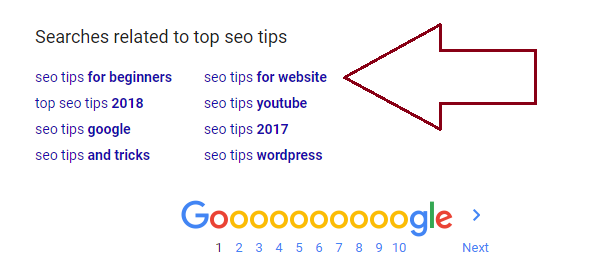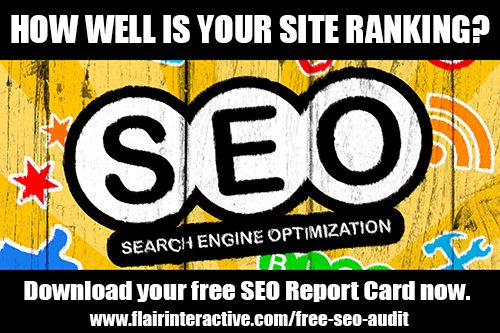 SEO tips are easy to come by, but sometimes navigating what's important and the order of priority can be overwhelming. If I've just described your feelings on SEO, then this one goes out to you.
SEO tips are easy to come by, but sometimes navigating what's important and the order of priority can be overwhelming. If I've just described your feelings on SEO, then this one goes out to you.
We deal with SEO all. day. long., so we know the best ways to improve it by simply (and consistently) using the right combination of tactics across all your content.
Learn everything you need to be doing – from the basic (do your keyword research), to the not-so-well-known (optimize your alt tags) – to get the best results from your SEO efforts.
- Conduct thorough and complete keyword research – then use your keywords appropriately
• Drill down to long tail keywords. One of our fave tools? Google Suggest - use this for secondary keywords. Type your keyword into the Google search bar,
but DON'T click enter - look at the suggestions Google provides in the drop down. Brilliant. Easy.• Use your primary keyword within the first 150 words of your article or page copy.
• Subheads are GREAT places to use your keywords.
• Don’t stuff (over-use) keywords in your copy (yuck - spammy) – instead, create a list of alternative ways to phrase your keyword/topic. Find synonyms using
either of the following methods.
OPTION 1: Latent Semantic Indexing (LSI) – keywords that complement your main topic. For example: Writing about Top SEO Tips? You can also use:-easy SEO tips
-effective SEO
-SEO in 2018
-SEO best practices
-SEO tips and tricks 2018
-top [x] SEO tips
OPTION 2: Searches related to your keyword – type your keyword into Google's search bar and scroll down to the bottom of the search results.
- Persona development
• Take the time to go through a full and exhaustive Persona development exercise.
• Personas are fictional characters of "who" your audience is – what, exactly, is your primary demographic?
-female?
-aged 35 - 45?
-shops at Target?
-researches online to comparison shop before making any big purchases?
-pain points?
-uses Facebook and Pinterest as her top two social platforms?
-income?
• Persona development brings all this to the surface, and once you identify these markers, you're off to races with a clear picture of what your content should sound like so that your users can FIND you. This is the backbone of inbound marketing. - Title tags
• Title tags are the clickable titles displayed in search engine result pages (SERP) that allow users to get TO your content FROM their Google search.
• Be sure to use your primary keyword, and (this is key) put it toward the front of your title.
• Do NOT repeat or duplicate your titles – every page and post should have a unique title tag.
• Keep in mind length - Google will cut off long titles, so your titles should be 70 characters or less (including spaces). -
Meta descriptions
• Just like your titles, you want your meta descriptions to be keyword-rich, relevant, unique and convincing.
• Character-limits apply here, too...300 characters or less (yes, also including spaces).
- Use crawlable URLs
• Again, optimize with keywords.
• Make your URLs short, relevant and specific. - Optimize your alt tags
• Alt tags are the titles you give your images.
• Google has a hard time reading images, so you want to create tags that are descriptive, and...yep, you guessed it, optimized.
• Every image on your blog or site should have an appropriate alt tag. - Link
• Ditch that old "learn more" or "click here" anchor text, and instead use content that shows readers where they'll end up if they click on your link. And don't forget to set you links to open a new window.
-EXTERNAL LINKS: Links that take users away from your site. Be appropriate with your linking. This part isn’t rocket science. You want to use reliable, authoritative links to sites that rank well and are respected in the eyes of Google. Use enough, but not too many (five - seven is generally a good number, depending on how long your article is. Seven links in a 300-word article? Too many.)
-INTERNAL LINKS: Links that point back to yourself – your CTA is a good place to do this, and as you start to produce content regularly, you’ll build a content-rich library you can link back to in future articles. - Write authoritative content
• You spend a lot of time, money and effort on your SEO, so don't waste it by producing fluff.
• Becoming a thought leader in your space is hard work, but pays off in the end. - Install Yoast (WordPress users)
• Yoast is a free WordPress plugin that allows you to quickly and easily stay on top of your SEO practices and optimize your site the way search engines (cough, Google) likes it.
I could do dozens of blogs on how to improve your SEO and still not cover everything you need to know about optimizing content. Luckily for you, Flair can help improve your SEO on all fronts. Reach out today to learn more about how Flair helps brands just like yours learn SEO techniques that work.
Image courtesy of Maklay62 via Pixabay

